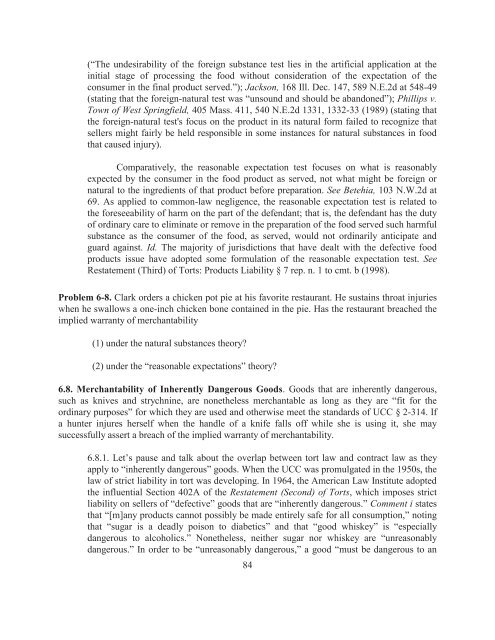Sales and Leases - A Problem-based Approach, 2016a
Sales and Leases - A Problem-based Approach, 2016a
Sales and Leases - A Problem-based Approach, 2016a
Create successful ePaper yourself
Turn your PDF publications into a flip-book with our unique Google optimized e-Paper software.
(“The undesirability of the foreign substance test lies in the artificial application at the<br />
initial stage of processing the food without consideration of the expectation of the<br />
consumer in the final product served.”); Jackson, 168 Ill. Dec. 147, 589 N.E.2d at 548-49<br />
(stating that the foreign-natural test was “unsound <strong>and</strong> should be ab<strong>and</strong>oned”); Phillips v.<br />
Town of West Springfield, 405 Mass. 411, 540 N.E.2d 1331, 1332-33 (1989) (stating that<br />
the foreign-natural test's focus on the product in its natural form failed to recognize that<br />
sellers might fairly be held responsible in some instances for natural substances in food<br />
that caused injury).<br />
Comparatively, the reasonable expectation test focuses on what is reasonably<br />
expected by the consumer in the food product as served, not what might be foreign or<br />
natural to the ingredients of that product before preparation. See Betehia, 103 N.W.2d at<br />
69. As applied to common-law negligence, the reasonable expectation test is related to<br />
the foreseeability of harm on the part of the defendant; that is, the defendant has the duty<br />
of ordinary care to eliminate or remove in the preparation of the food served such harmful<br />
substance as the consumer of the food, as served, would not ordinarily anticipate <strong>and</strong><br />
guard against. Id. The majority of jurisdictions that have dealt with the defective food<br />
products issue have adopted some formulation of the reasonable expectation test. See<br />
Restatement (Third) of Torts: Products Liability § 7 rep. n. 1 to cmt. b (1998).<br />
<strong>Problem</strong> 6-8. Clark orders a chicken pot pie at his favorite restaurant. He sustains throat injuries<br />
when he swallows a one-inch chicken bone contained in the pie. Has the restaurant breached the<br />
implied warranty of merchantability<br />
(1) under the natural substances theory?<br />
(2) under the “reasonable expectations” theory?<br />
6.8. Merchantability of Inherently Dangerous Goods. Goods that are inherently dangerous,<br />
such as knives <strong>and</strong> strychnine, are nonetheless merchantable as long as they are “fit for the<br />
ordinary purposes” for which they are used <strong>and</strong> otherwise meet the st<strong>and</strong>ards of UCC § 2-314. If<br />
a hunter injures herself when the h<strong>and</strong>le of a knife falls off while she is using it, she may<br />
successfully assert a breach of the implied warranty of merchantability.<br />
6.8.1. Let’s pause <strong>and</strong> talk about the overlap between tort law <strong>and</strong> contract law as they<br />
apply to “inherently dangerous” goods. When the UCC was promulgated in the 1950s, the<br />
law of strict liability in tort was developing. In 1964, the American Law Institute adopted<br />
the influential Section 402A of the Restatement (Second) of Torts, which imposes strict<br />
liability on sellers of “defective” goods that are “inherently dangerous.” Comment i states<br />
that “[m]any products cannot possibly be made entirely safe for all consumption,” noting<br />
that “sugar is a deadly poison to diabetics” <strong>and</strong> that “good whiskey” is “especially<br />
dangerous to alcoholics.” Nonetheless, neither sugar nor whiskey are “unreasonably<br />
dangerous.” In order to be “unreasonably dangerous,” a good “must be dangerous to an<br />
84


















